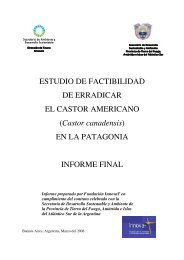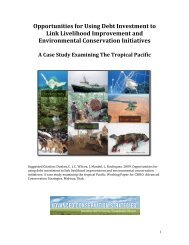Isabela eps:Layout 1 - Advanced Conservation Strategies
Isabela eps:Layout 1 - Advanced Conservation Strategies
Isabela eps:Layout 1 - Advanced Conservation Strategies
You also want an ePaper? Increase the reach of your titles
YUMPU automatically turns print PDFs into web optimized ePapers that Google loves.
MANAGEMENT<br />
& STRATEGY<br />
14<br />
Eradication methods<br />
“On large islands a range of methods used sequentially<br />
and simultaneously are required to put all animals at risk”<br />
Strategic use of methods<br />
Throughout all our eradication work we followed some simple rules. Where possible as close to 100 % of the animals were<br />
removed on their first encounter, reducing the possibility that survivors learn from their exposure to a certain hunting<br />
method. We studied the vegetation type, topography and goat densities; and hunters’ efforts revolved heavily around<br />
techniques to minimize escapes. For example, on Santiago mustering was used in the highlands in the first months as this<br />
was the only practical method by which herds of thousands of animals could be removed with near zero escapes. In<br />
eradication, efficacy (being efficient and effective) is a combination of minimizing cost per kill and maximizing the ratio of<br />
goats killed to escapes. Each method is suited to different terrain, vegetation type and goat densities. This creates a hierarchy<br />
of methods that can be used sequentially. The development of wary animals to any one method requires a change in<br />
methods to place those animals at risk. In various situations it is also highly<br />
advantageous to use different methods simultaneously.<br />
Aerial hunting<br />
Landscape or vegetation type offer refuge for goats from one or more<br />
methods; however no vegetation or terrain type provides refuge for goats from<br />
all methods. On Santiago goats found refuge from ground hunters with dogs<br />
in lava fields, a place where aerial hunting excels. Conversely, goats found<br />
refuge from helicopters by remaining motionless under vegetation and by<br />
hiding under thick vegetation and in caves; these areas and tactics then made<br />
goats vulnerable to ground hunters with dogs. On a large scale and on<br />
complex islands, a refuge will likely exist for most methods. As such, on large<br />
islands a range of methods used sequentially and simultaneously is required<br />
to put all animals at risk.<br />
Ground based mustering and corrals<br />
In order to channel goats into corrals, we used netting strung out in large<br />
“wings” up to several kilometers in length. This method was developed to<br />
facilitate the removal of vast herds of goats that could not effectively be<br />
removed by other means without significant numbers of escapes. Prior to the<br />
arrival of helicopters this method was fundamental as an initial knock-down<br />
tool, and was very cost-effective.<br />
In the 1970s New Zealanders began using helicopters intensively as aerial shooting<br />
platforms and for recovering deer carcasses for a demanding European market. Aerial<br />
shooting is now practiced extensively in Australia and New Zealand to control feral<br />
animals cost-effectively and on a large scale. Contrary to common belief this method is<br />
actually endorsed by animal welfare organizations as the most humane method of<br />
removing feral goats in rough terrain. It is highly effective in sparsely vegetated areas or<br />
areas with trees with open canopy; the majority of <strong>Isabela</strong> and large tracts of Santiago<br />
fit this description. Aerial shooting is cost-effective at high and low animal densities and<br />
allows for the rapid coverage of large areas.<br />
Ground hunting<br />
Traditional hunting, or, as we’ve dubbed it, free hunting, involves individual or pairs of<br />
hunters with or without their dogs hunting freely within a zone. This allows hunters to<br />
concentrate their efforts and use various hunting tactics in areas where goats are frequent,<br />
such as hill-tops, rocky ridges, cliffs, craters and lines of caves. This method<br />
is most efficient when goats are at high, medium and low densities. Skilled and motivated<br />
hunters are required. Large areas can be effectively covered with multiple camps of 2-3<br />
hunters spaced throughout.<br />
Mata Haris is a line-hunting technique adopted and improved from our local hunters and<br />
conservation practitioners in New Zealand. The technique involves a team of hunters<br />
working at fixed spacing (100-150m) and systematically moving through an area, typically<br />
proceeding into or perpendicular to the prevailing wind. Hunters maintain their place in<br />
the line by radio communications and hand-held GPSs with pre-determined points from<br />
the GIS. In this way, we produced a coordinated wall of hunters and dogs optimally spaced<br />
and covering swaths typically 3 km wide. This method is ideal for detecting animals at very low densities and covering areas<br />
systematically; it ensures that all areas are covered, and even the most wary animals are at risk. Deployment/retrieval of<br />
hunters and dogs by helicopter allows them to work remote areas and still remain ‘fresh’ for when goats are detected.<br />
Dogs<br />
Eradication methods<br />
“On large islands a range of methods used sequentially<br />
and simultaneously are required to put all animals at risk”<br />
New Zealand is the only country in the world where specialist goat dogs are<br />
employed by many hunters, providing breeds that facilitate training of pups due<br />
to natural instincts. A core breeding and training stock of five dogs was imported<br />
from New Zealand in 2000 and specialist dog trainers from there were employed<br />
to train hunters and develop trainers and a team of specialist goat dogs. Other<br />
hunting dogs from the Galapagos were selected for skills missing in the imported<br />
team and a team of over 70 skilled dogs was developed within 2.5 years.<br />
Certification at basic and advanced levels maintained dogs at high standards,<br />
and aversion training was conducted to ensure dogs were species specific and showed no interest in native wildlife. Hunters<br />
would work with one or two dogs each. Dogs were finder-bailers (dogs that track, find and contain the goats while waiting for<br />
the hunter to arrive), and could typically work with ground and air scents to detect and find goats. Dogs are highly effective with<br />
small groups of goats at low densities. They perform well in dense vegetation where other methods are ineffective, making them<br />
a key element when confronted with vast areas of that vegetation.<br />
Judas goats<br />
Goats are highly social and gregarious animals; they have an aversion to<br />
isolation, and will seek out others when isolated. The Judas goat method<br />
exploits these elements of goat biology to increase the cost efficiency of<br />
control and eradication operations when animals are at low densities. Judas<br />
goats are selected, captured, fitted with radio telemetry collars and released.<br />
They can then be tracked down and any associated feral goats will be<br />
removed. The Judas goat method is used as an accessory to other hunting<br />
methods, being most commonly used in conjunction with aerial hunting by<br />
helicopter and ground hunting with and without dogs.<br />
Judas goats increase the efficiency of removing animals at low density by reducing search time for hunters locating remnant<br />
herds or individuals. However, we discovered on Pinta that current Judas goat methodology fell short of its potential efficacy.<br />
The ideal Judas goat would search strongly for goats, be searched for by other goats, be sterile and not become wary. Reasons<br />
that goats may search for conspecifics include isolation and sexual cues. To maintain Judas goats in a state of isolation,<br />
managers in addition to shooting feral goats, shoot or capture any additional Judas goats associated with a particular Judas<br />
goat. Sexual cues involve both sexes searching strongly for mates, particularly when females are in estrus. Females in estrus<br />
actively search for males and likely attract them using pheromones. We developed protocols to sterilize, terminate pregnancy<br />
and induce female goats into a prolonged estrus with hormone implants. We then compared the efficiency of three types of<br />
Judas goats; sterile male, sterile female and sterile females in a prolonged estrus which we have dubbed Mata Haris (after the<br />
seductive and lethal World War I double agent).<br />
MANAGEMENT<br />
& STRATEGY<br />
15





